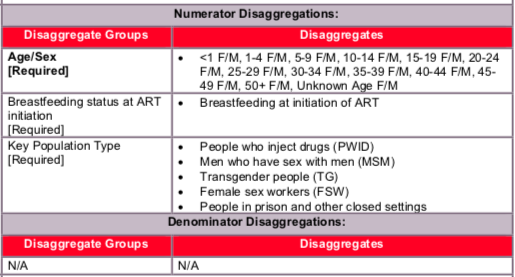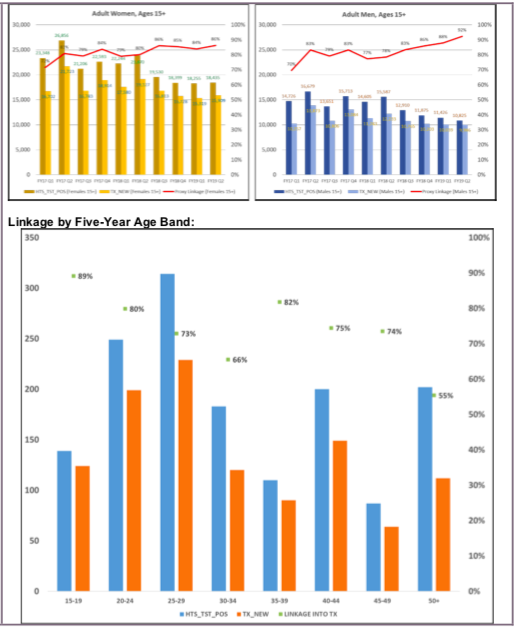(TX_NEW) Number of adults and children newly enrolled on antiretroviral therapy (ART)
Export Indicator
The indicator measures the ongoing scale-up and uptake of ART programs. This measure is critical to monitor along with number of patients currently on ART in relation to the number of PLHIV that are estimated to be eligible for treatment to assess progress in the program’s response to the epidemic in specific geographic areas and populations as well as at the national level. This is particularly critical in the context of current revisions to country- specific ART eligibility.
Reporting the number of new patients enrolled on ART at both the national and overall PEPFAR program levels is critical to monitoring the HIV services cascade, specifically the successful linkage between HIV diagnosis and initiating ART.
Disaggregation of new on ART by age/sex at ART initiation, and breastfeeding status at ART initiation is important to understand the percentage of new ART initiations coming from priority populations. Note that pregnancy status at ART initiation is captured in the PMTCT_ART indicator.
Number of adults and children newly enrolled on antiretroviral therapy (ART)
N/A
How to calculate annual total: Sum results across quarters
How to collect:
Facility ART registers/databases, program monitoring tools, or drug supply management systems.
- The numerator can be generated by counting the number of adults and children who are newly enrolled in ART in the reporting period, in accordance with the nationally approved treatment protocol (or WHO/UNAIDS standards).
- Patients who known to transfer in from another facility, or who temporarily stopped therapy and have started again should not be counted as new patients.
- Patients who have been off treatment from >28 days and restart ART should be counted in TX_RTT. They should not be counted in TX_NEW.
- NEW is a state defined by an individual initiating ART during the reporting period. It is expected that the characteristics of new clients are recorded at the time they newly initiate life-long ART. For example, patients who receive post-exposure prophylaxis (PEP), short term ART only for prevention (PrEP), or ART starter pack alone should not be used to count individuals reached with this indicator.
HIV-positive pregnant women who are eligible for and are newly receiving antiretroviral drugs for their own treatment are included in TX_NEW. HIV-positive pregnant women initiating lifelong ART through PMTCT (Option B+) will count as “current” on ART under TX_CURR.
BF disaggregation: Women who initiate ART while breastfeeding should be counted under this indicator but not in PMTCT_ART.
Key Populations (KPs):
Both KP-specific and clinical partners should complete these KP disaggregations, but only if safe to maintain these files and to report. Reporting of the key population disaggregation should be consistent with what is described under the KP_PREV “How to review for data quality” section on mutual exclusivity of an individual who falls under multiple KP categories (e.g., FSW who injects drugs). In such instances, the individual should only be reported in ONE KP disaggregation category with which this person is most identified. See Appendix A to support the identification of key populations at service delivery.
The first priority of data collection and reporting of treatment among key populations must be to do no harm. These data must be managed confidentially to ensure the identities of individuals are protected and to prevent further stigma and discrimination of key populations.
How to review for data quality:
- Numerator ≥ subtotal of each disaggregation: The total number of adults and children newly enrolled on ART should be greater or equal to the sum of all of the age/sex disaggregations and pregnancy/ breastfeeding status.
- Confirm that TX_CURR ≥ TX_NEW.
Reporting Level: Facility
Reporting frequency: Quarterly

The indicator measures the ongoing scale- up and uptake of ART programs
Indicator changes (MER 2.0 v2.3 to v2.4): None
Standard definition of DSD and TA-SDI used.
Provision of key staff or commodities for PLHIV receiving ART includes: the provision of key staff and/or commodities can include ongoing procurement of critical commodities, such as ARVs, or funding for salaries of HCW who deliver HIV treatment services. Staff who are responsible for the completeness and quality of routine patient records (paper or electronic) can be counted here; however, staff who exclusively fulfill MOH and donor reporting requirements cannot be counted.
Ongoing support for PLHIV receiving ART service delivery improvement includes: clinical mentoring and supportive supervision of staff at HIV sites providing ART, support for quality improvement activities, patient tracking system support, routine support of ART M&E and reporting, commodities consumption forecasting and supply management.
Guiding narrative questions:
- If TX_NEW does NOT equal HTS_TST_POS, explain why.
- If TX_NEW result is markedly different from targets, explain why.
- Describe your rationale for reporting TX_NEW vs. TX_RTT. How are you ensuring that patients that transfer in, were LTFU from treatment, or stopped treatment are NOT being counted in TX_NEW at the time they reinitiate treatment?
